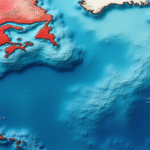Introduction
According to the National Institute of Statistics and Geography (Inegi), Chiapas, Oaxaca, and Guerrero are the Mexican states with the most significant digital divide. These southern entities exhibit the lowest indicators in internet access, mobile phone usage, and adoption of smart technologies.
Chiapas: The State with the Greatest Digital Divide
Chiapas has the largest digital divide in the country. Only 64.9% of its population aged six and above has internet access, with just 50.7% of households having this service. Furthermore, 62.5% of Chiapas’ inhabitants use a mobile phone, and only 9.6% of households possess smart devices, as per the National Household Survey on Availability and Use of Information Technologies (ENDUTIH).
By 2024, 73.6% of households had internet access, equating to 28.8 million households. The survey estimated that 100.2 million people used the internet, representing 83.1% of the population aged six and above, an increase of 1.9% from 2023.
“Internet users in rural areas grew by 2.5% compared to 2023, but regional disparities remain,” explained Mauricio Márquez Corona, vice president of Inegi’s Governing Board. For instance, Sonora has 91.3% internet users compared to Chiapas’ 64.9%, a gap of 26 percentage points.
Oaxaca and Guerrero: Persistent Digital Divide
Oaxaca continues to be on this critical list of disconnection, with 69.2% of its inhabitants as internet users and only 55.5% of households having access to the network. In mobile phone usage, Oaxaca has 69.6% users, and smart device penetration in households barely reaches 10.5%.
Guerrero completes the trio of states with the most significant digital divide, with 72.1% internet users, 58.9% connected households, 73.5% mobile phone penetration, and 11.7% smart device adoption.
“Equitable access to these technologies can help reduce inequalities by contributing to economic and social development. It can also support access to education, healthcare, information, citizen participation, or expand economic opportunities,” added Márquez Corona.
Contrasts: Sonora and the Ciudad de México Lead in Digital Access
In stark contrast, Sonora leads with 91.3% of its population aged six and above using the internet, the highest mobile phone penetration at 90.8%, and shares the top spot with the Ciudad de México, having 84.4% of households with internet access.
The capital city also leads in smart technology adoption, with 38% of households equipped with these devices. Quintana Roo stands out with 90.7% internet users and 88% mobile phone penetration, while Nuevo León follows closely with 83.7% households having internet access and 36.7% smart device adoption.
Key Questions and Answers
- What is the digital divide? The digital divide refers to the gap between individuals, households, businesses, and geographic areas at different socio-economic levels with regard to their opportunities to access information and communication technologies (ICTs).
- Which states have the most significant digital divide in Mexico? Chiapas, Oaxaca, and Guerrero have the most significant digital divide in Mexico.
- What are the main indicators of digital divide? The primary indicators include internet access, mobile phone usage, and adoption of smart technologies.
- What are the consequences of the digital divide? The digital divide can exacerbate social and economic inequalities by limiting access to education, healthcare, information, citizen participation, and economic opportunities.
- Which states have the best digital access indicators? Sonora and the Ciudad de México lead in digital access indicators.






